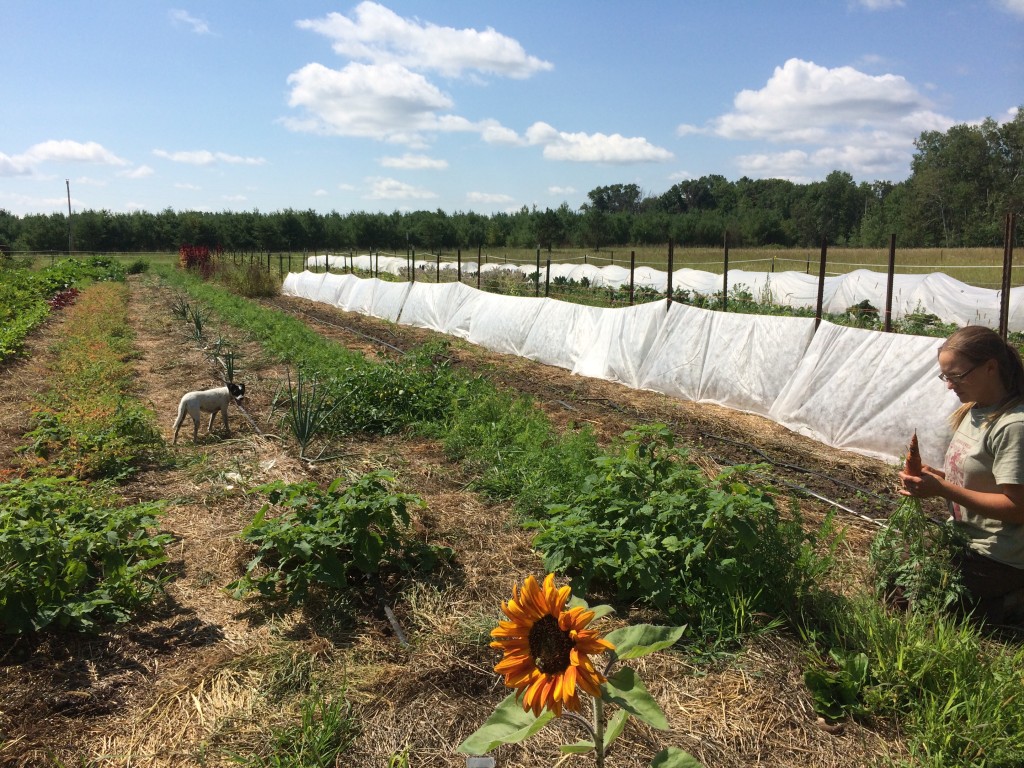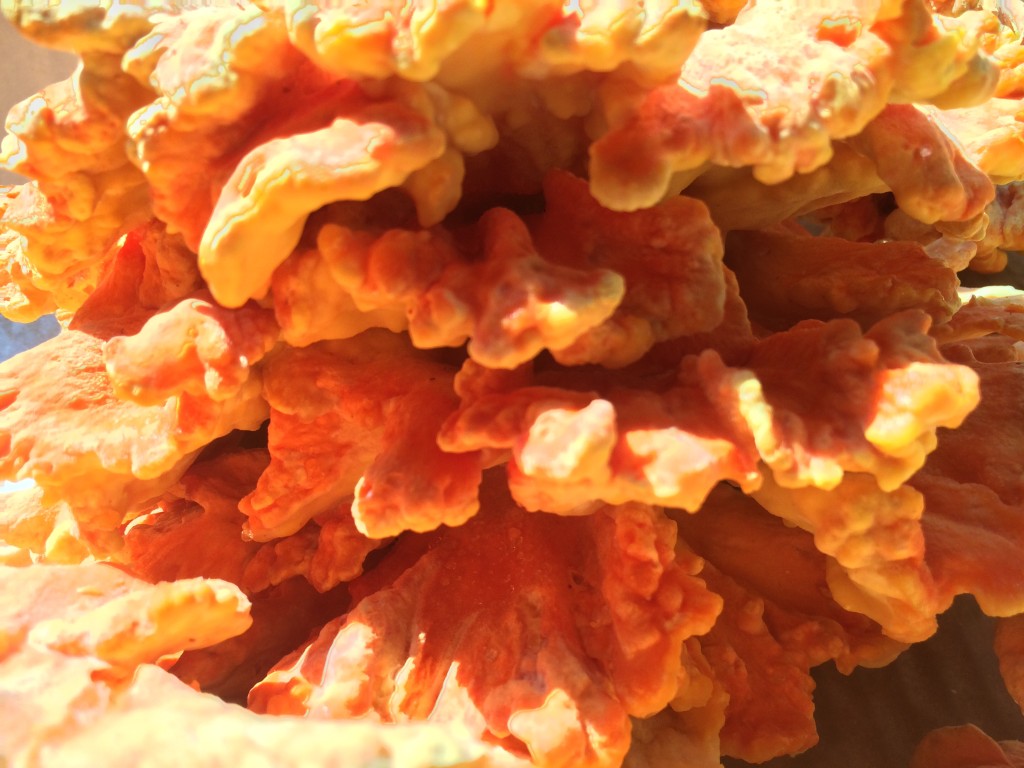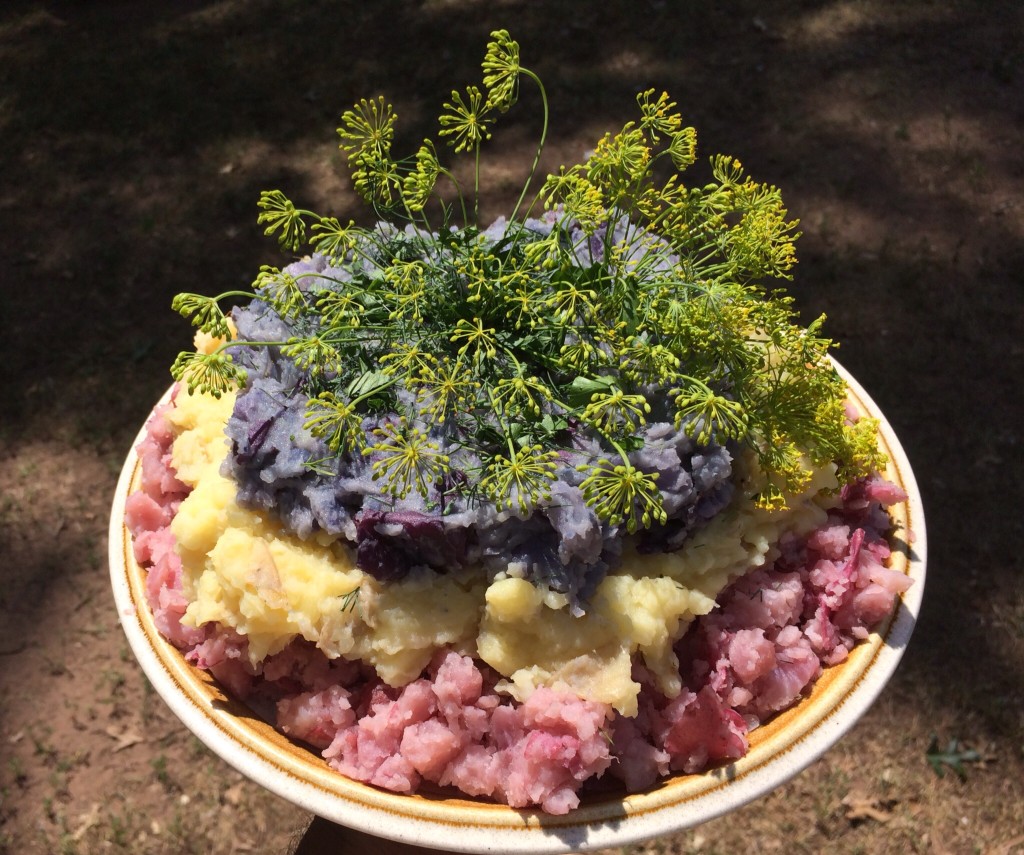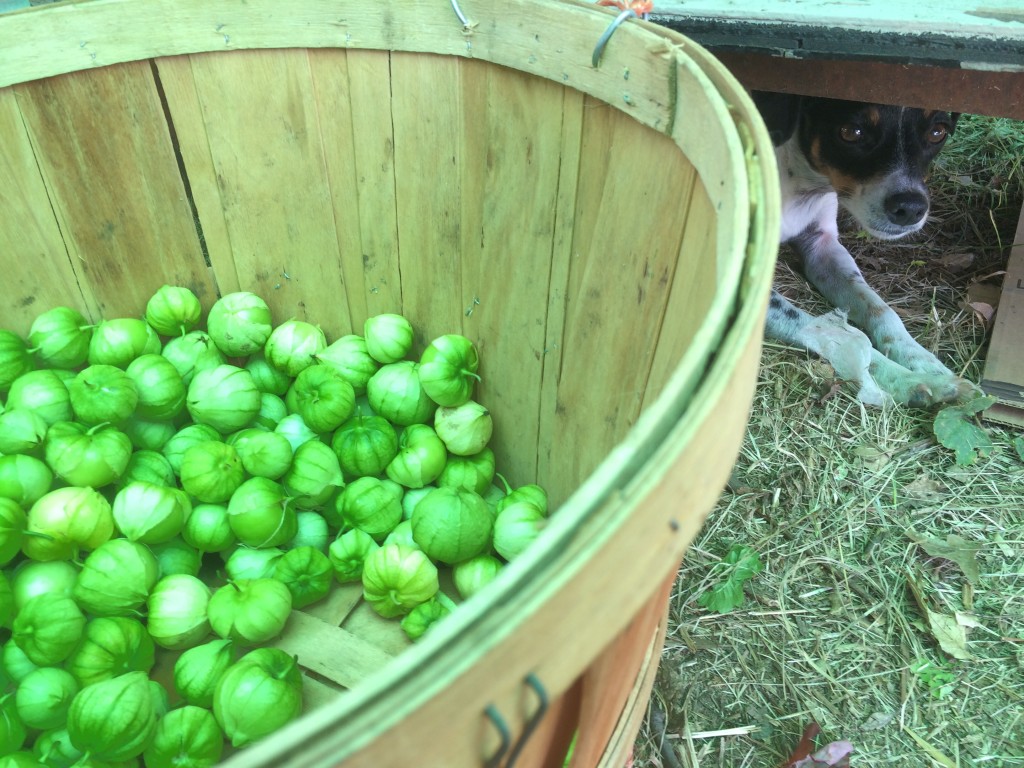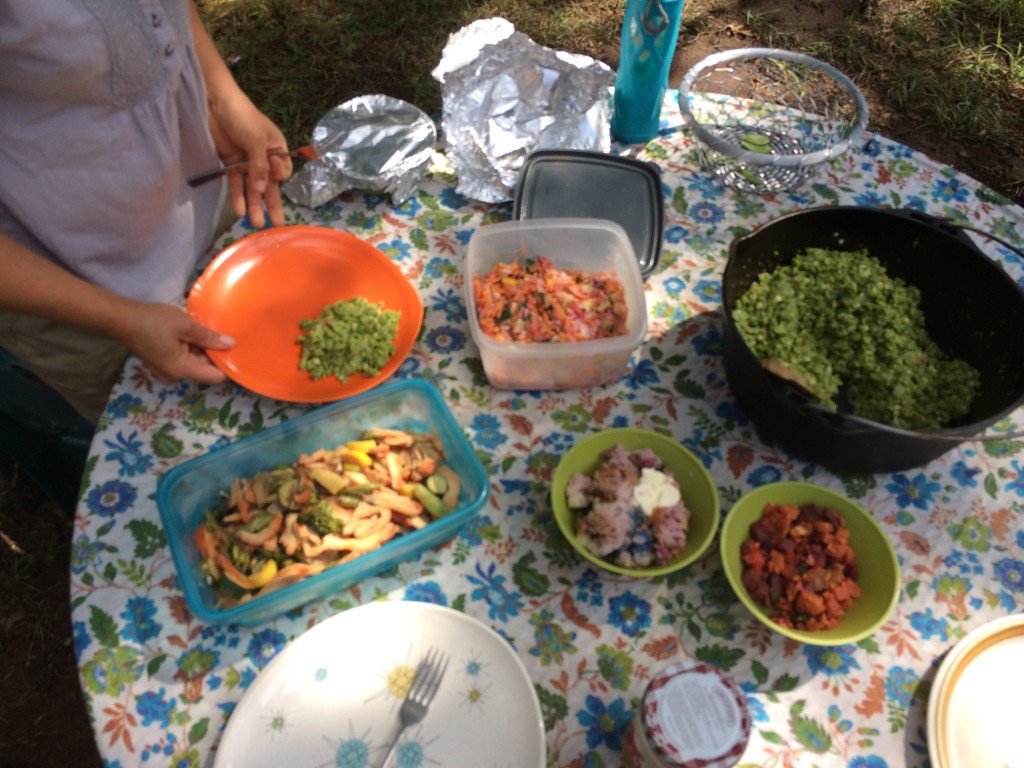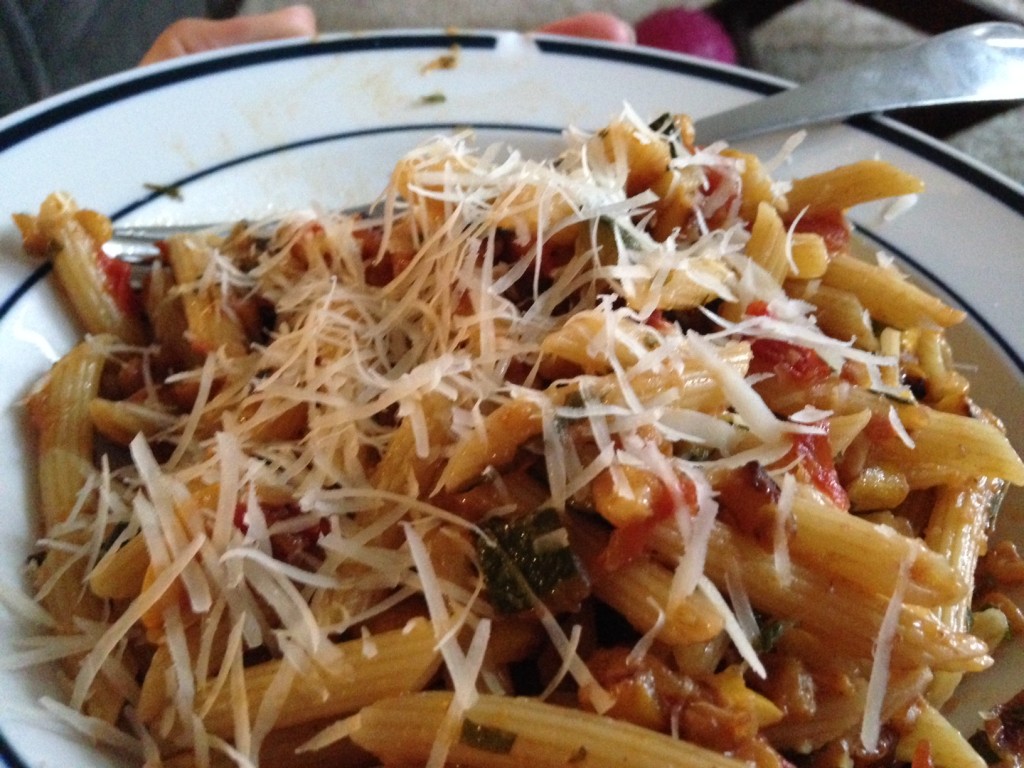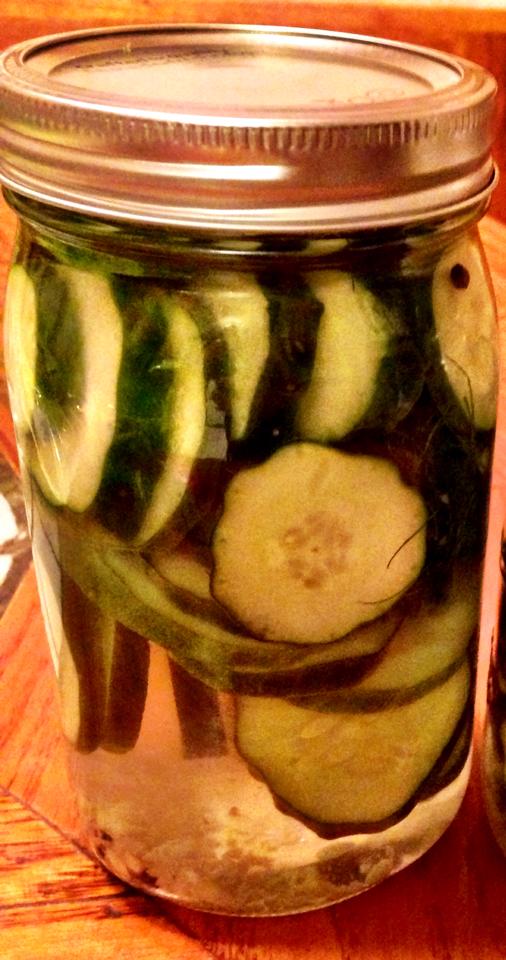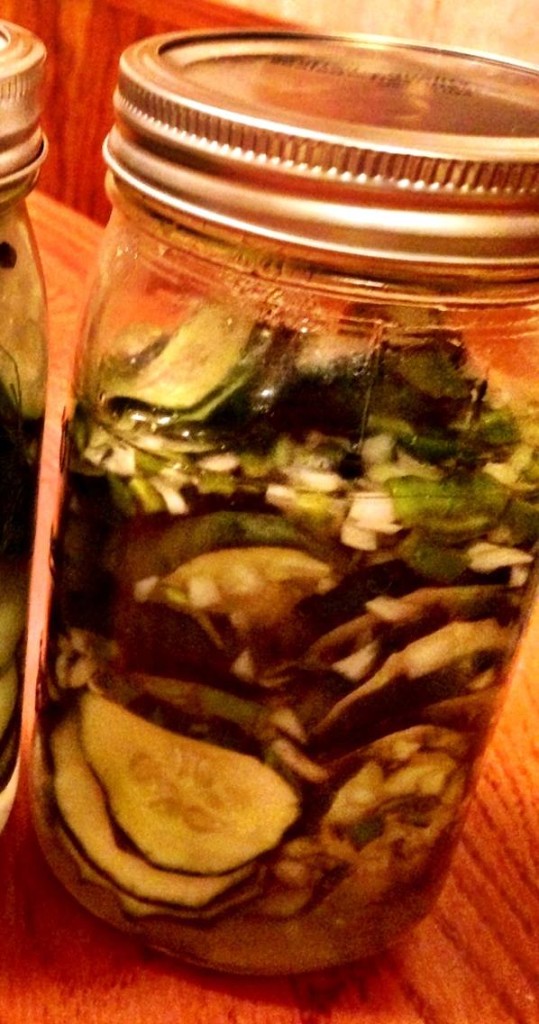The Weekly News
It’s been a long week – we’re glad that our annual weekend vacation has arrived, and we’ll be off the farm for the weekend, staying at a cabin in nature with friends and family, recharging and regrounding, rebooting and renewing. It hasn’t been a bad week, just a long one, and at this time of summer it is really nice to be able to unplug for a bit, not wake up and go to bed each day with vegetables and to-do lists swirling endlessly through your waking and dreaming thoughts.
The week started off as the last few weeks have been, weatherwise – dry as a bone. Even running the gravity drip irrigation daily, the crops were showing the stress of the daily heat and the persistent lack of rain. It is uniquely stressful to look out at a field of crops with drooping, sad leaves.
On top of the drought, the summertime pests have kicked their game into gear. In addition to the hateful squash vine borers we continued to surgically-strike, the squash bugs have taken to the stage, appearing in their myriad forms – clusters of bronzed eggs on the undersides of the leaves, little nymphs of all sizes dancing along the stems, and a handful of early roach-looking adults scuttling among them. These are the most evasive little suckers. Literally, suckers – they drain the vitality from the already-struggling squash plants with their sucking mouthparts, and they run and hide when they see you coming, stopping, dropping, and rolling into the mulch when you attempt to squash them. When you do manage to catch them, they smell like some kind of gross candy from childhood that you can never quite place, but which was most likely the same unnatural color of teal as their guts are.
Worse, the cucumber beetles – the striped black and yellow menaces, are out in record numbers this year. And they don’t limit themselves to cucumber plants – they also love squash. And melons. And all kinds of other things. While they don’t do a lot of direct damage by their feeding habits, they harbor single-celled farm terrorists in their guts that infect plants with bacterial wilt – which is incurable, inexorable – and inevitably fatal.
So the squash – which had been growing in majestic and triumphant glory, have been battered by three pests plus drought, beaten back into a condition that tends to make as sad rather than smile when we walk among them. There are huge squash everywhere – but you cannot count squash before they ripen. They take a long season to get to the point they’re tastily edible, and the hurdles they must cross are among the most treacherous an organic vegetable faces, unaided by arsenals of pesticide.

By Monday, we were getting serious in our desire for some rain. Rain dancing was discussed with WWOOFer Sean informed us that holding turquoise under running water was said to help bring the rains … it didn’t seem like a compelling plan. But we were hot and parched and ready to avoid the bludgeon of the afternoon sun, so we headed to the Saint Croix with the dogs to take a swim – and of course, I was wearing my dad’s turquoise ring.
And lo, it turns out turquoise rocks really do bring rain if you put em in a river! This is now an Established Scientific Fact, because after we got back to the Farm, the rain started … slowly at first, very very slowly. But then more fell, and more – and soon the trickle turned to a soaking downpour. And the pour kept on downing, hour after hour, all throughout the night – it rained steadily for over 12 hours, dropping almost two inches onto the parched landscape, bringing the drooping leaves and the corners of our smiles back up where they belong. We set out every bucket and pail and wheelbarrow we had, in the open and under driplines from roofs, gathering precious moisture for future use, in case the rain stayed away for weeks again.
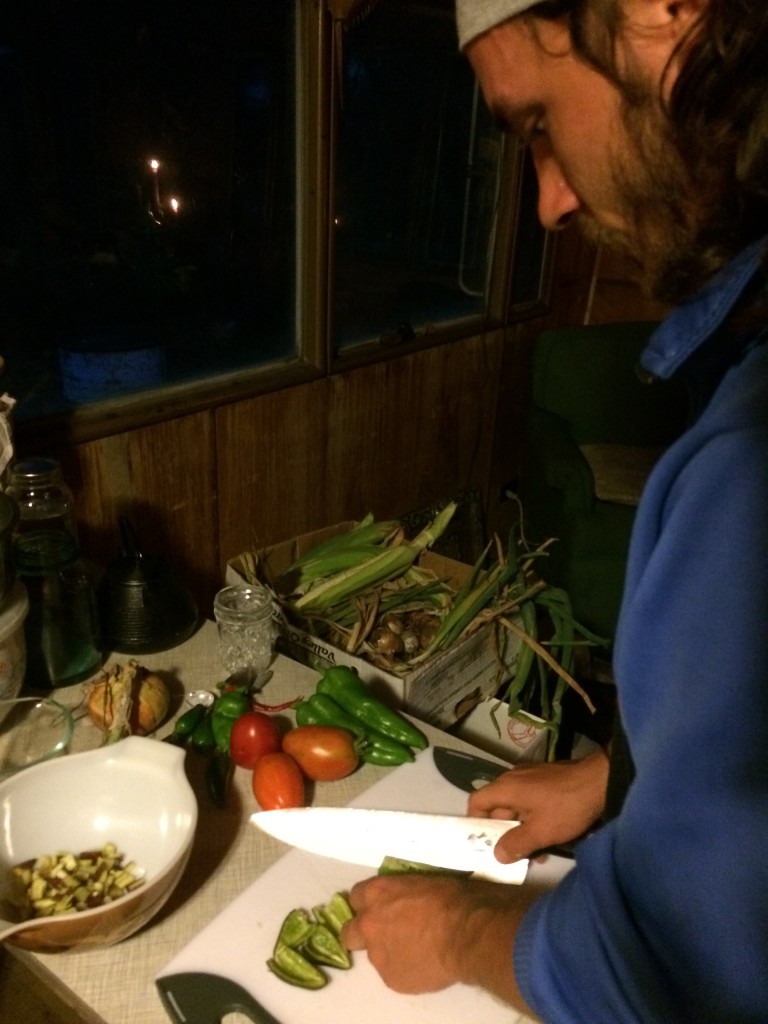
The next day we seized the opportunity to retain soil moisture among the unmulched pepper rows – adding layers of paper topped with a thick hay mulch. We transplanted some new cool season crop seedlings out of the greenhouse and into the field – spinach into the row cover where cabbages had once been, and new cabbages and broccolis under shade tent a-frames draped over the trellises from which we’d recently removed the snap pea plants.
Hmmm, what else happened this week … our new rooster, Curly, somehow got himself trapped beneath one of the 5-gallon pails we use as nest boxes – we fortunately found him before he was roasted or suffocated – but we still have no idea how he managed to get himself in such a predicament. We do, however, suspect that the hens may have had something to do with it.
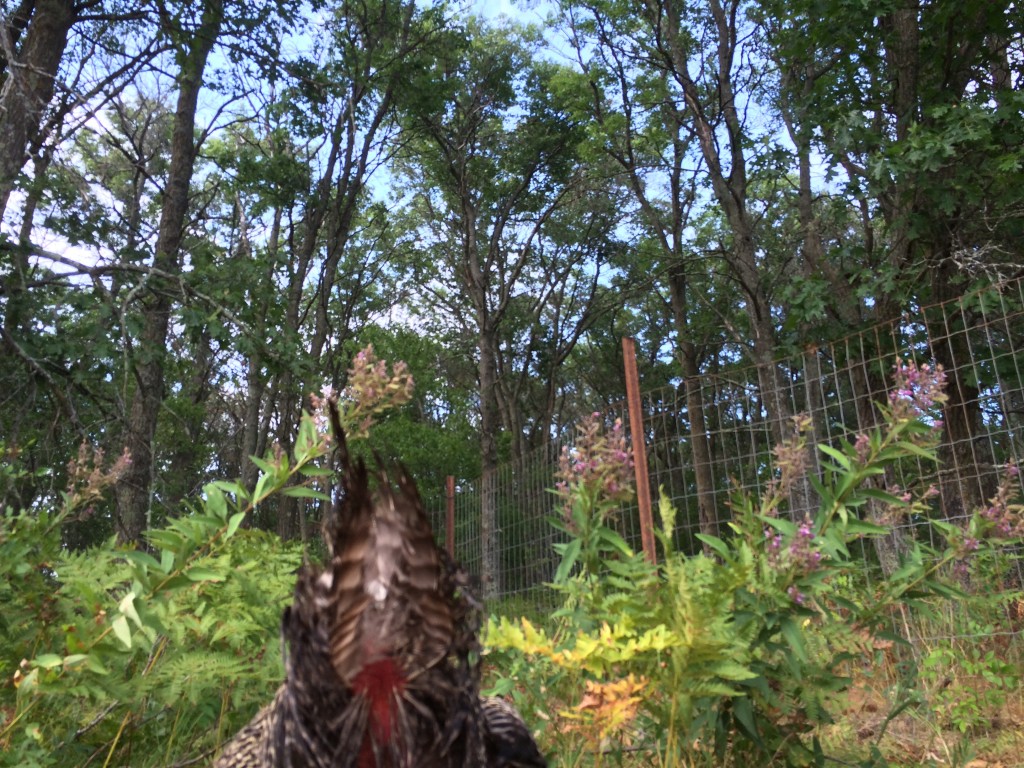
We weeded out fistfuls of horrifically spiked sandbur grass from the one corner of the field prone to it, and stalked the fluttering, ridiculously evasive cabbage looper moths with a butterfly net (scored free from Craigslist last year). Hijinks ensued – I wish there was video of me chasing through the field, flailing and swearing and laughing as I mostly missed but occasionally captured and killed the deceptively-pretty white moths (which deposit clusters of future ravenous caterpillars on plants such as cabbage, broccoli, and the like). We found another gorgeous and tasty giant Chicken of the Woods mushroom!
At night, the coyotes and the owls compete to see who can made the eeriest, most hair-raising cacophony. This week, the coyotes are winning.

Yesterday, Widget discovered a skunk skulking beneath the semitrailer barn – it sprayed at her but missed. The entire area reeked of skunk all day. The coop is next door to the semitrailer, and skunks are chicken eggs thieves and chicken murderers, so we put out the live trap donated to us by some lovely shareholders, baited with catfood. We really didn’t WANT to catch a skunk and have to figure out how to dispose of it, dead or alive, so we were relieved to find the trap empty in the morning. The dogs seem uninterested in the trailers underside today, so we’re hoping the malodorous menace has moved on … but we’re leaving the trap out just in case.
The Weekly Box
The boxes are getting hefty now! Open yours up to discover:
- Potatoes – mostly “All Blue” variety potatoes this week, with some reds and Yukon Golds as well.
- Tomatoes – an assortment of what’s (finally) starting to ripen … there are many varieties being grown, and only some are red when ripe – there are yellow tomatoes, and varieties that have a dusky, greenish cast to their skins even when fully ripe. To further complicate things and make your tomato-eating more interesting, we’ve picked some for you that are almost-but-not-quite ripe.. So how can you tell if a given tomato is ripe, when color is an unreliable guide? Feel em – if they are hard, they’re not ripe yet. A ripe tomato will give slightly to the touch – not soft, but … slightly yielding. Store them in a paper bag, loosely closed, and they will ripen nicely – or go the old-school route and place them in a window ledge where they’ll get little sunshine. Just don’t ever put them in the fridge!
- Kale – Curly Blue, Dinosaur, & Red Russian varieties
- Onion
- Garlic
- either Broccoli or Beans or Okra (or two of the above, if you have a Large share box)
- two kinds of Basil
- Peppers – an assortment of sweet (Green Bell, Italian Frying, Carmen Peppers, Sirenvyi) and spicy (Czech Black, Golden Cayenne, Red Cayenne, Serrano)!
- Zucchini – still can’t stop, still won’t stop. We’ve been eating them in stir-frys and pancakes this week, ourselves – here’s some inspiration if you’d like some!
- Cucumbers – Lemon & slicer varieties
- Sweet Corn – Sugar Buns & Candy Corn varieties
Weekly Recipes from the Shareholders
Got one to share? send it in! if we have the ingredients in a future box we can share it in the newsletter … previously we’d been posting them to the Facebook page, but this might make more sense we reckon.
Pasta with Corn, Zucchini, and Tomatoes
By Mark Bittman – pic and recipe sent to us by Lizzy Wilkins
From the How to Cook Everything app
Introduction:
A summer mélange of whatever is on hand, tossed with pasta. Like ratatouille, this is flexible not only in its seasonings but also in its main ingredients: You can use onions, garlic, or shallots, singly or in combination; add green beans (or fresh limas) to the mix; substitute eggplant for the zucchini.
Ingredients:
- Salt
- 3 tablespoons extra virgin olive oil or 2 tablespoons oil and 1 tablespoon butter
- 1 cup corn kernels (from 2 or 3 ears of corn)
- 1 cup diced zucchini or summer squash (about 5 ounces)
- Freshly ground black pepper
- 1 medium onion or 3 or 4 shallots, finely chopped
- ¼ teaspoon minced garlic (optional)
- 1 tablespoon chopped fresh tarragon leaves
- 4 plum tomatoes or 2 large ripe tomatoes, diced
- 1 pound cut pasta, like penne, rigatoni, or fusilli
Steps:
- Bring a large pot of water to a boil and salt it. Put 2 tablespoons of the oil in a large skillet over medium‐high heat. When hot, add the corn and cook, stirring only occasionally, until the corn is dry and really beginning to brown, about 5 minutes. Add the zucchini and some salt and pepper. Cook, stirring occasionally, until the zucchini begins to brown.
- Add the onion and the garlic if you’re using it. Cook, stirring occasionally, until the onion softens, about 5 minutes. Add the tarragon and cook for 30 seconds, then add the tomatoes and continue cooking while you cook the pasta.
- Cook the pasta in the boiling water until tender but not mushy. If the sauce dries out (with plum tomatoes, this is likely), add some of the pasta‐cooking water, about ¼ cup at a time, to thin it somewhat but not make it a soup. When the pasta is done, drain it and toss with the sauce and the remaining oil or the butter. Taste and adjust the seasoning and serve immediately.
Miscellaneous From Lizzy:
Beet greens and broccoli and soba noodles: http://www.annaliisakapp.com/
Green beans and peaches: http://www.epicurious.com/
Zucchini cornbread (it says 55-65 minutes, but mine didn’t cook through until 75-80 grr): http://www.epicurious.com/
Zucchini fritters:http://markbittman.
Sweet Pickles
Recipe by Melissa Hickman
Ingredients:
1 c distilled white vinegar
1 tbsp salt
2 cups white sugar
6 cups sliced cucumbers
1 cup chopped onions
1 cup chopped green bell peppers
Directions:
Over medium heat, bring vinegar, salt and sugar to a boil. Boil until the sugar has completely dissolved.
Place the cucumbers, onions and peppers in a large bowl. Pour vinegar mixture over the vegetables. Let cool some.
Transfer to sterile containers and store in the refrigerator. Give it 24-48 hours before eating so that the flavors have a chance to meld together.
Hints:
Use this as a good base – play around a bit. Add less sugar for less sweet pickles. Add red pepper flakes to add some zing to your sweet. Use different bell peppers. The first batch I did was exactly the recipe, but the second time around, I only had green onions and a purple pepper and some obscure pepper from my CSA. I also ran out of white sugar so used raw sugar crystals instead. I think this batch will be even better (I’ll find out in 2 days when we try them!!).
Dill Pickles
Recipe by Melissa Hickman
Ingredients:
2 to 3 cucumbers
5 springs of fresh dill (or 1 tbsp dry)
2-4 cloves are garlic, crushed and minced
3 tbsp distilled white vinegar
¾ tbsp salt, to taste
20 peppercorns
¼ tsp red pepper flakes, optional
Filtered water (enough to top off the jar)
Directions:
Cut pickles into discs, spears, or sandwich slices and add everything to a 1-quart mason jar EXCEPT the water. Once everything is in the jar, fill to the top with the filtered water. Screw the lid on tightly, so as not to leak. Shake up the jar to distribute the flavors and leave on your countertop for 12 hours. Shake it again and flip upside down for another 12 hours. Enjoy within a month for maximum freshness.
Hints:
You can do this with just about any vegetable. Eliminate the dill and use okra, bell peppers, etc. get creative!


